Leadership Skills, Qualities, Development, and Management Report
VerifiedAdded on 2021/02/19
|13
|3680
|30
Report
AI Summary
This report delves into the multifaceted aspects of leadership, examining the essential skills and qualities that define a successful leader. It explores the traits of effective leaders, including courage, diligence, responsiveness, and flexibility, and highlights the importance of communication, commitment, and continuous learning. The report also addresses leadership development, providing insights into how individuals can cultivate leadership abilities through initiative, critical thinking, effective listening, motivation, discipline, and conflict resolution. Furthermore, it distinguishes between leadership and management, outlining the core differences in their approaches and focuses. Leadership is presented as an art of inspiring and motivating people, while management is described as the process of organizing and coordinating tasks to achieve organizational goals. The report also touches on transformational and situational leadership theories, emphasizing the need for leaders to adapt their styles based on specific circumstances.
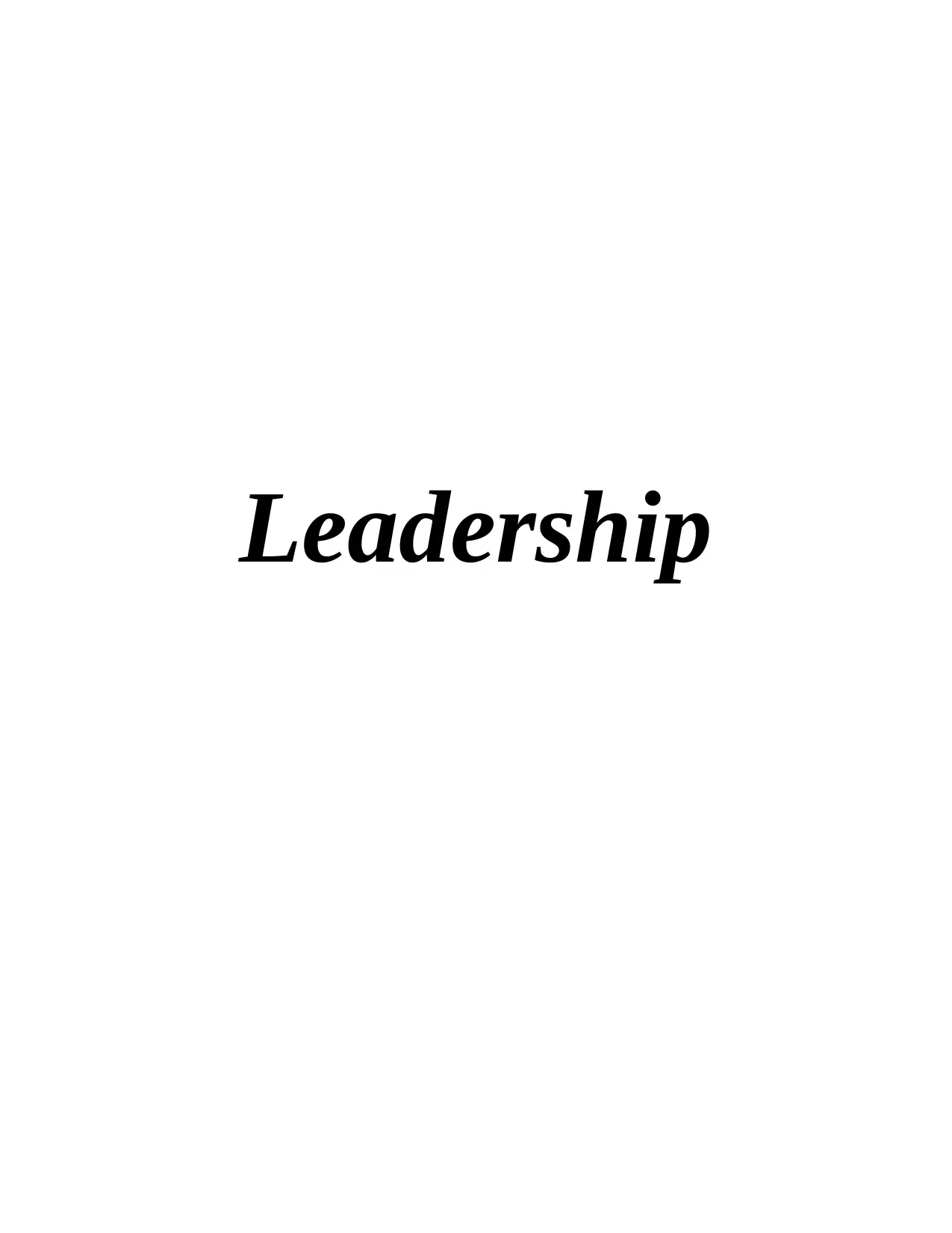
Leadership
Paraphrase This Document
Need a fresh take? Get an instant paraphrase of this document with our AI Paraphraser
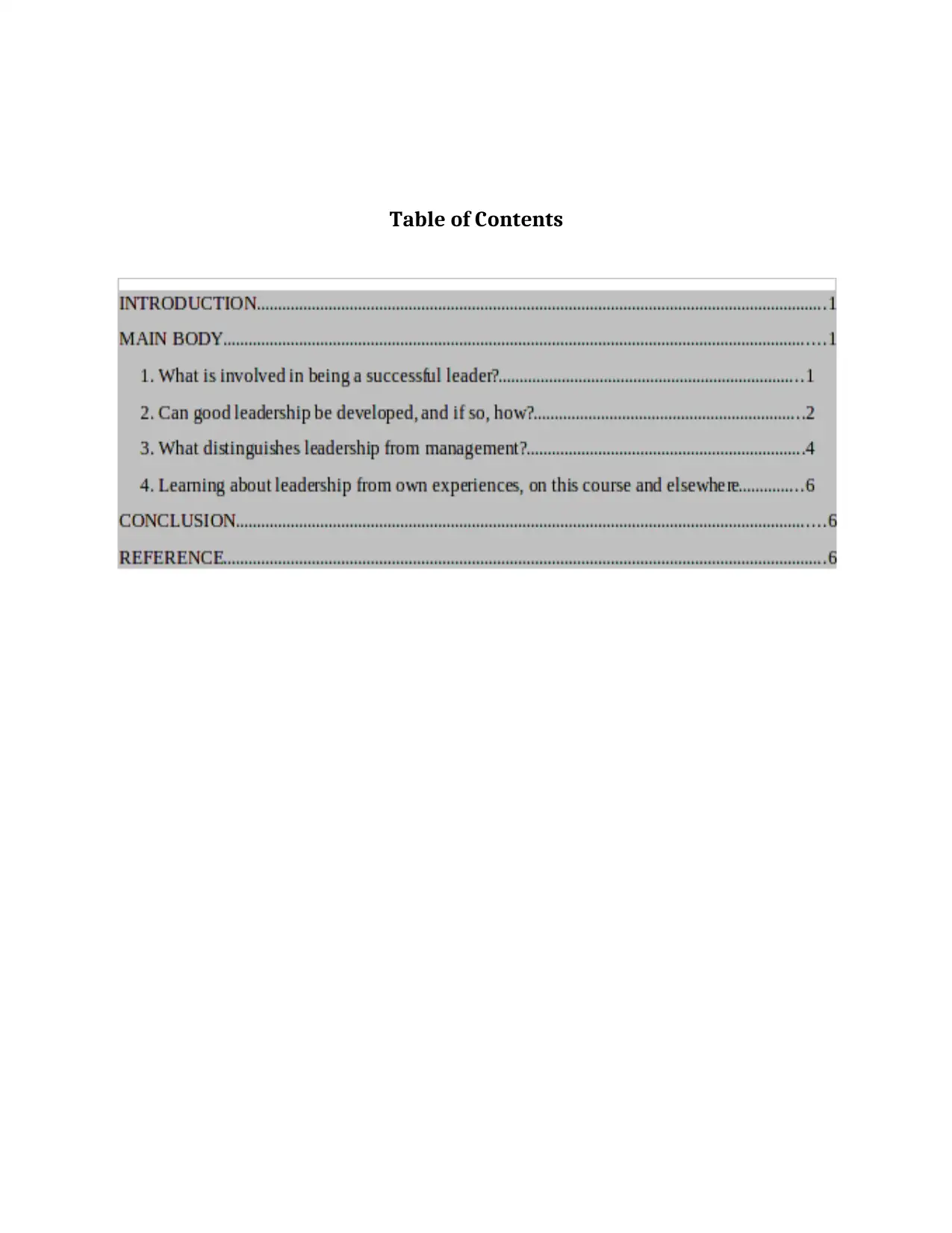
Table of Contents
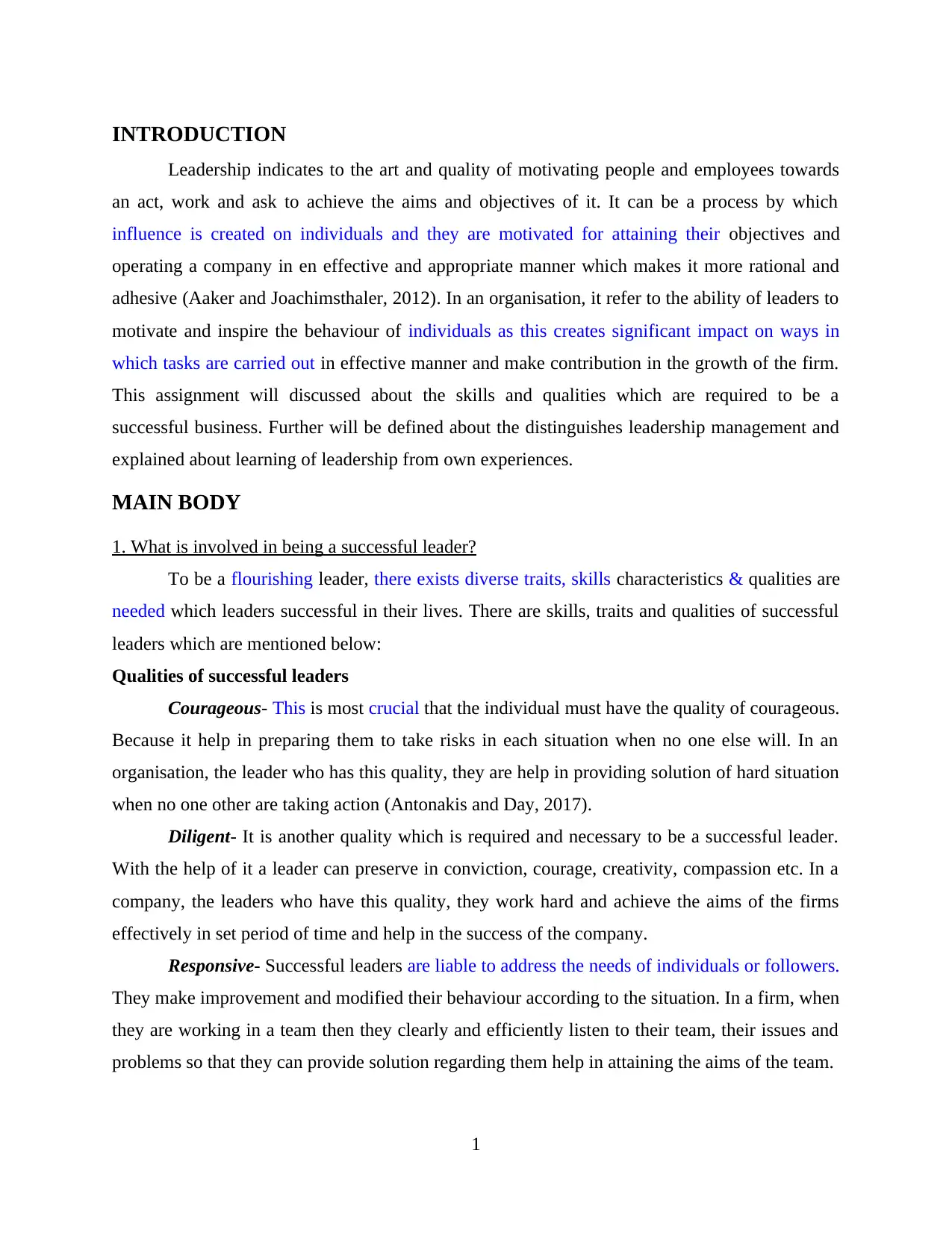
INTRODUCTION
Leadership indicates to the art and quality of motivating people and employees towards
an act, work and ask to achieve the aims and objectives of it. It can be a process by which
influence is created on individuals and they are motivated for attaining their objectives and
operating a company in en effective and appropriate manner which makes it more rational and
adhesive (Aaker and Joachimsthaler, 2012). In an organisation, it refer to the ability of leaders to
motivate and inspire the behaviour of individuals as this creates significant impact on ways in
which tasks are carried out in effective manner and make contribution in the growth of the firm.
This assignment will discussed about the skills and qualities which are required to be a
successful business. Further will be defined about the distinguishes leadership management and
explained about learning of leadership from own experiences.
MAIN BODY
1. What is involved in being a successful leader?
To be a flourishing leader, there exists diverse traits, skills characteristics & qualities are
needed which leaders successful in their lives. There are skills, traits and qualities of successful
leaders which are mentioned below:
Qualities of successful leaders
Courageous- This is most crucial that the individual must have the quality of courageous.
Because it help in preparing them to take risks in each situation when no one else will. In an
organisation, the leader who has this quality, they are help in providing solution of hard situation
when no one other are taking action (Antonakis and Day, 2017).
Diligent- It is another quality which is required and necessary to be a successful leader.
With the help of it a leader can preserve in conviction, courage, creativity, compassion etc. In a
company, the leaders who have this quality, they work hard and achieve the aims of the firms
effectively in set period of time and help in the success of the company.
Responsive- Successful leaders are liable to address the needs of individuals or followers.
They make improvement and modified their behaviour according to the situation. In a firm, when
they are working in a team then they clearly and efficiently listen to their team, their issues and
problems so that they can provide solution regarding them help in attaining the aims of the team.
1
Leadership indicates to the art and quality of motivating people and employees towards
an act, work and ask to achieve the aims and objectives of it. It can be a process by which
influence is created on individuals and they are motivated for attaining their objectives and
operating a company in en effective and appropriate manner which makes it more rational and
adhesive (Aaker and Joachimsthaler, 2012). In an organisation, it refer to the ability of leaders to
motivate and inspire the behaviour of individuals as this creates significant impact on ways in
which tasks are carried out in effective manner and make contribution in the growth of the firm.
This assignment will discussed about the skills and qualities which are required to be a
successful business. Further will be defined about the distinguishes leadership management and
explained about learning of leadership from own experiences.
MAIN BODY
1. What is involved in being a successful leader?
To be a flourishing leader, there exists diverse traits, skills characteristics & qualities are
needed which leaders successful in their lives. There are skills, traits and qualities of successful
leaders which are mentioned below:
Qualities of successful leaders
Courageous- This is most crucial that the individual must have the quality of courageous.
Because it help in preparing them to take risks in each situation when no one else will. In an
organisation, the leader who has this quality, they are help in providing solution of hard situation
when no one other are taking action (Antonakis and Day, 2017).
Diligent- It is another quality which is required and necessary to be a successful leader.
With the help of it a leader can preserve in conviction, courage, creativity, compassion etc. In a
company, the leaders who have this quality, they work hard and achieve the aims of the firms
effectively in set period of time and help in the success of the company.
Responsive- Successful leaders are liable to address the needs of individuals or followers.
They make improvement and modified their behaviour according to the situation. In a firm, when
they are working in a team then they clearly and efficiently listen to their team, their issues and
problems so that they can provide solution regarding them help in attaining the aims of the team.
1
⊘ This is a preview!⊘
Do you want full access?
Subscribe today to unlock all pages.

Trusted by 1+ million students worldwide
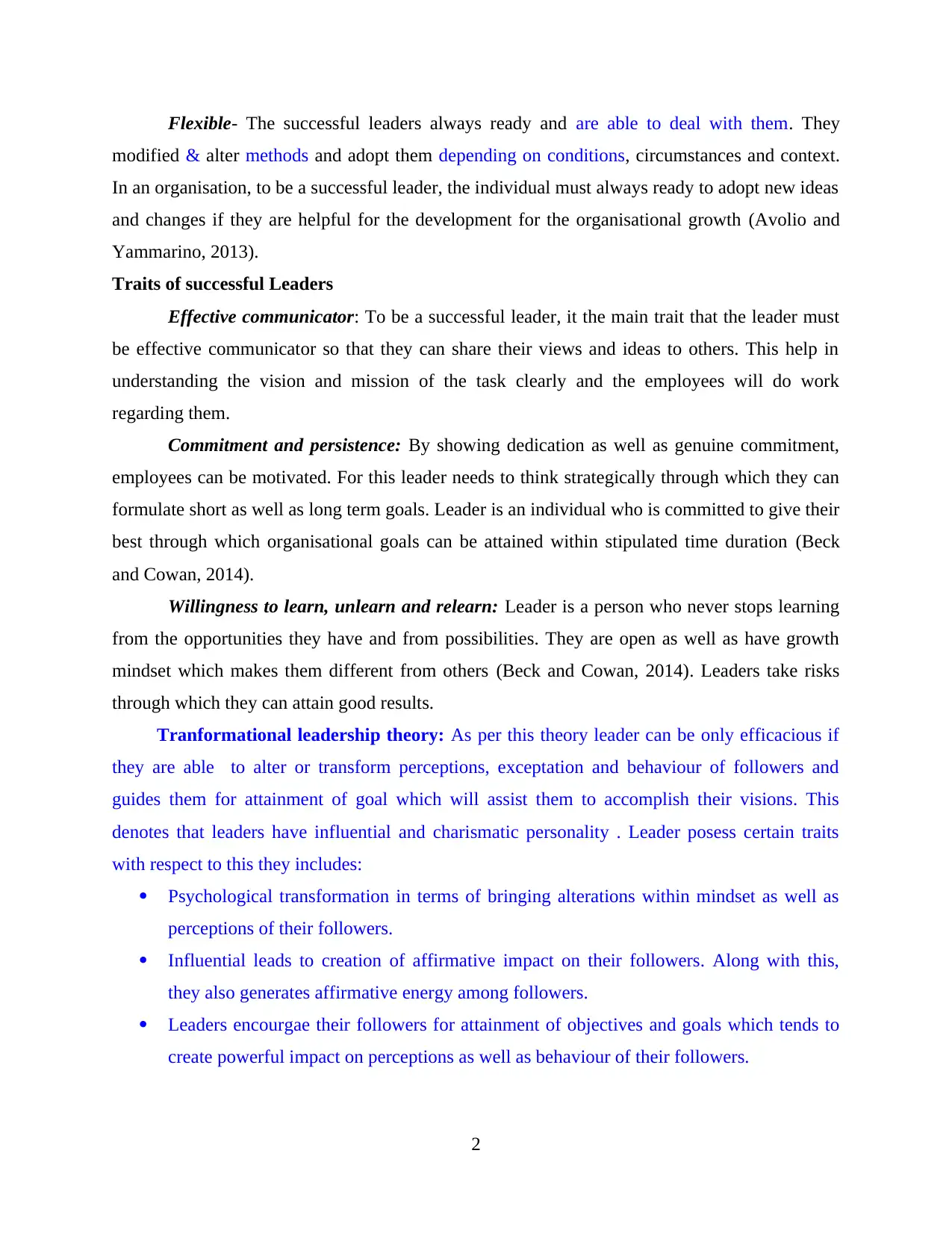
Flexible- The successful leaders always ready and are able to deal with them. They
modified & alter methods and adopt them depending on conditions, circumstances and context.
In an organisation, to be a successful leader, the individual must always ready to adopt new ideas
and changes if they are helpful for the development for the organisational growth (Avolio and
Yammarino, 2013).
Traits of successful Leaders
Effective communicator: To be a successful leader, it the main trait that the leader must
be effective communicator so that they can share their views and ideas to others. This help in
understanding the vision and mission of the task clearly and the employees will do work
regarding them.
Commitment and persistence: By showing dedication as well as genuine commitment,
employees can be motivated. For this leader needs to think strategically through which they can
formulate short as well as long term goals. Leader is an individual who is committed to give their
best through which organisational goals can be attained within stipulated time duration (Beck
and Cowan, 2014).
Willingness to learn, unlearn and relearn: Leader is a person who never stops learning
from the opportunities they have and from possibilities. They are open as well as have growth
mindset which makes them different from others (Beck and Cowan, 2014). Leaders take risks
through which they can attain good results.
Tranformational leadership theory: As per this theory leader can be only efficacious if
they are able to alter or transform perceptions, exceptation and behaviour of followers and
guides them for attainment of goal which will assist them to accomplish their visions. This
denotes that leaders have influential and charismatic personality . Leader posess certain traits
with respect to this they includes:
Psychological transformation in terms of bringing alterations within mindset as well as
perceptions of their followers.
Influential leads to creation of affirmative impact on their followers. Along with this,
they also generates affirmative energy among followers.
Leaders encourgae their followers for attainment of objectives and goals which tends to
create powerful impact on perceptions as well as behaviour of their followers.
2
modified & alter methods and adopt them depending on conditions, circumstances and context.
In an organisation, to be a successful leader, the individual must always ready to adopt new ideas
and changes if they are helpful for the development for the organisational growth (Avolio and
Yammarino, 2013).
Traits of successful Leaders
Effective communicator: To be a successful leader, it the main trait that the leader must
be effective communicator so that they can share their views and ideas to others. This help in
understanding the vision and mission of the task clearly and the employees will do work
regarding them.
Commitment and persistence: By showing dedication as well as genuine commitment,
employees can be motivated. For this leader needs to think strategically through which they can
formulate short as well as long term goals. Leader is an individual who is committed to give their
best through which organisational goals can be attained within stipulated time duration (Beck
and Cowan, 2014).
Willingness to learn, unlearn and relearn: Leader is a person who never stops learning
from the opportunities they have and from possibilities. They are open as well as have growth
mindset which makes them different from others (Beck and Cowan, 2014). Leaders take risks
through which they can attain good results.
Tranformational leadership theory: As per this theory leader can be only efficacious if
they are able to alter or transform perceptions, exceptation and behaviour of followers and
guides them for attainment of goal which will assist them to accomplish their visions. This
denotes that leaders have influential and charismatic personality . Leader posess certain traits
with respect to this they includes:
Psychological transformation in terms of bringing alterations within mindset as well as
perceptions of their followers.
Influential leads to creation of affirmative impact on their followers. Along with this,
they also generates affirmative energy among followers.
Leaders encourgae their followers for attainment of objectives and goals which tends to
create powerful impact on perceptions as well as behaviour of their followers.
2
Paraphrase This Document
Need a fresh take? Get an instant paraphrase of this document with our AI Paraphraser
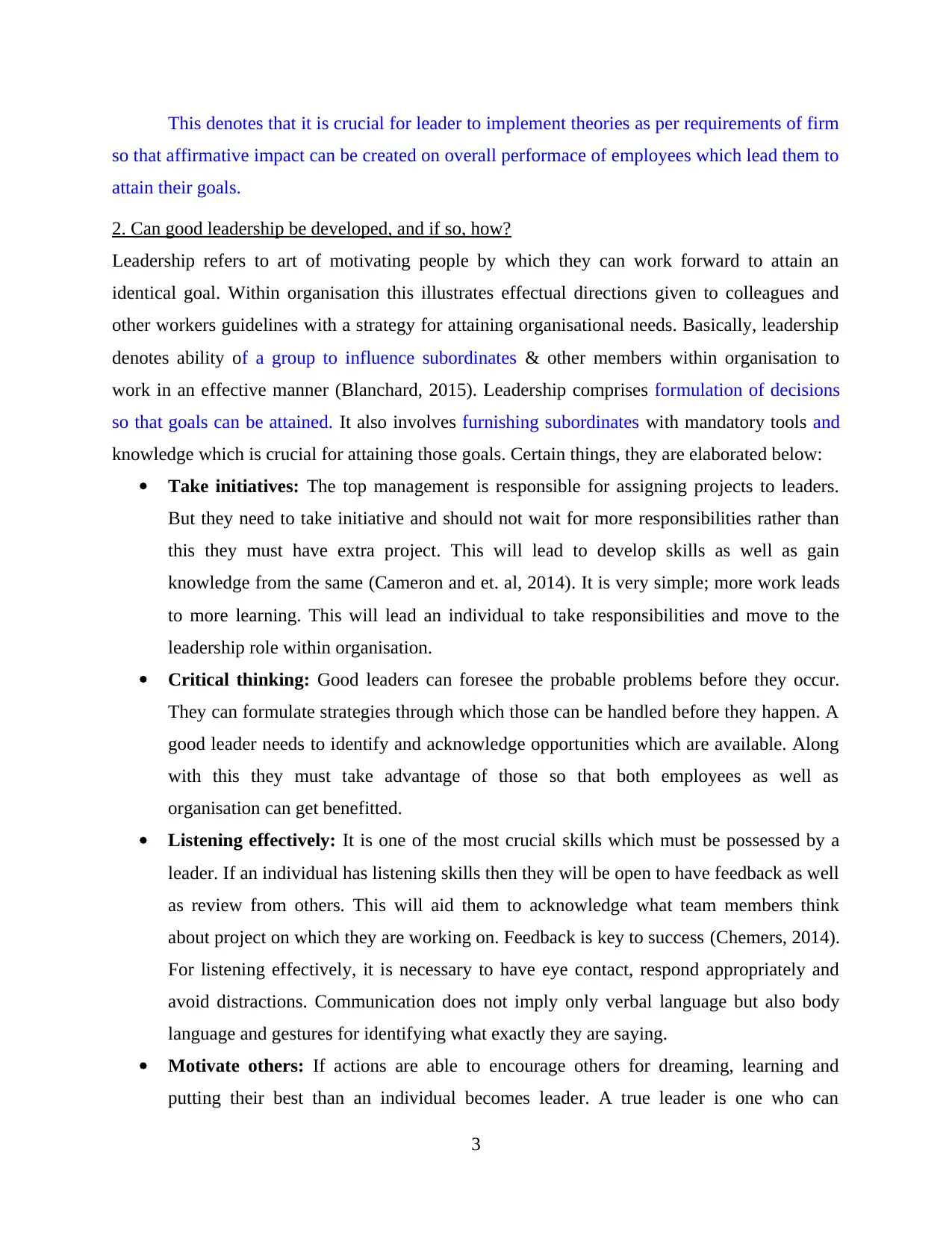
This denotes that it is crucial for leader to implement theories as per requirements of firm
so that affirmative impact can be created on overall performace of employees which lead them to
attain their goals.
2. Can good leadership be developed, and if so, how?
Leadership refers to art of motivating people by which they can work forward to attain an
identical goal. Within organisation this illustrates effectual directions given to colleagues and
other workers guidelines with a strategy for attaining organisational needs. Basically, leadership
denotes ability of a group to influence subordinates & other members within organisation to
work in an effective manner (Blanchard, 2015). Leadership comprises formulation of decisions
so that goals can be attained. It also involves furnishing subordinates with mandatory tools and
knowledge which is crucial for attaining those goals. Certain things, they are elaborated below:
Take initiatives: The top management is responsible for assigning projects to leaders.
But they need to take initiative and should not wait for more responsibilities rather than
this they must have extra project. This will lead to develop skills as well as gain
knowledge from the same (Cameron and et. al, 2014). It is very simple; more work leads
to more learning. This will lead an individual to take responsibilities and move to the
leadership role within organisation.
Critical thinking: Good leaders can foresee the probable problems before they occur.
They can formulate strategies through which those can be handled before they happen. A
good leader needs to identify and acknowledge opportunities which are available. Along
with this they must take advantage of those so that both employees as well as
organisation can get benefitted.
Listening effectively: It is one of the most crucial skills which must be possessed by a
leader. If an individual has listening skills then they will be open to have feedback as well
as review from others. This will aid them to acknowledge what team members think
about project on which they are working on. Feedback is key to success (Chemers, 2014).
For listening effectively, it is necessary to have eye contact, respond appropriately and
avoid distractions. Communication does not imply only verbal language but also body
language and gestures for identifying what exactly they are saying.
Motivate others: If actions are able to encourage others for dreaming, learning and
putting their best than an individual becomes leader. A true leader is one who can
3
so that affirmative impact can be created on overall performace of employees which lead them to
attain their goals.
2. Can good leadership be developed, and if so, how?
Leadership refers to art of motivating people by which they can work forward to attain an
identical goal. Within organisation this illustrates effectual directions given to colleagues and
other workers guidelines with a strategy for attaining organisational needs. Basically, leadership
denotes ability of a group to influence subordinates & other members within organisation to
work in an effective manner (Blanchard, 2015). Leadership comprises formulation of decisions
so that goals can be attained. It also involves furnishing subordinates with mandatory tools and
knowledge which is crucial for attaining those goals. Certain things, they are elaborated below:
Take initiatives: The top management is responsible for assigning projects to leaders.
But they need to take initiative and should not wait for more responsibilities rather than
this they must have extra project. This will lead to develop skills as well as gain
knowledge from the same (Cameron and et. al, 2014). It is very simple; more work leads
to more learning. This will lead an individual to take responsibilities and move to the
leadership role within organisation.
Critical thinking: Good leaders can foresee the probable problems before they occur.
They can formulate strategies through which those can be handled before they happen. A
good leader needs to identify and acknowledge opportunities which are available. Along
with this they must take advantage of those so that both employees as well as
organisation can get benefitted.
Listening effectively: It is one of the most crucial skills which must be possessed by a
leader. If an individual has listening skills then they will be open to have feedback as well
as review from others. This will aid them to acknowledge what team members think
about project on which they are working on. Feedback is key to success (Chemers, 2014).
For listening effectively, it is necessary to have eye contact, respond appropriately and
avoid distractions. Communication does not imply only verbal language but also body
language and gestures for identifying what exactly they are saying.
Motivate others: If actions are able to encourage others for dreaming, learning and
putting their best than an individual becomes leader. A true leader is one who can
3
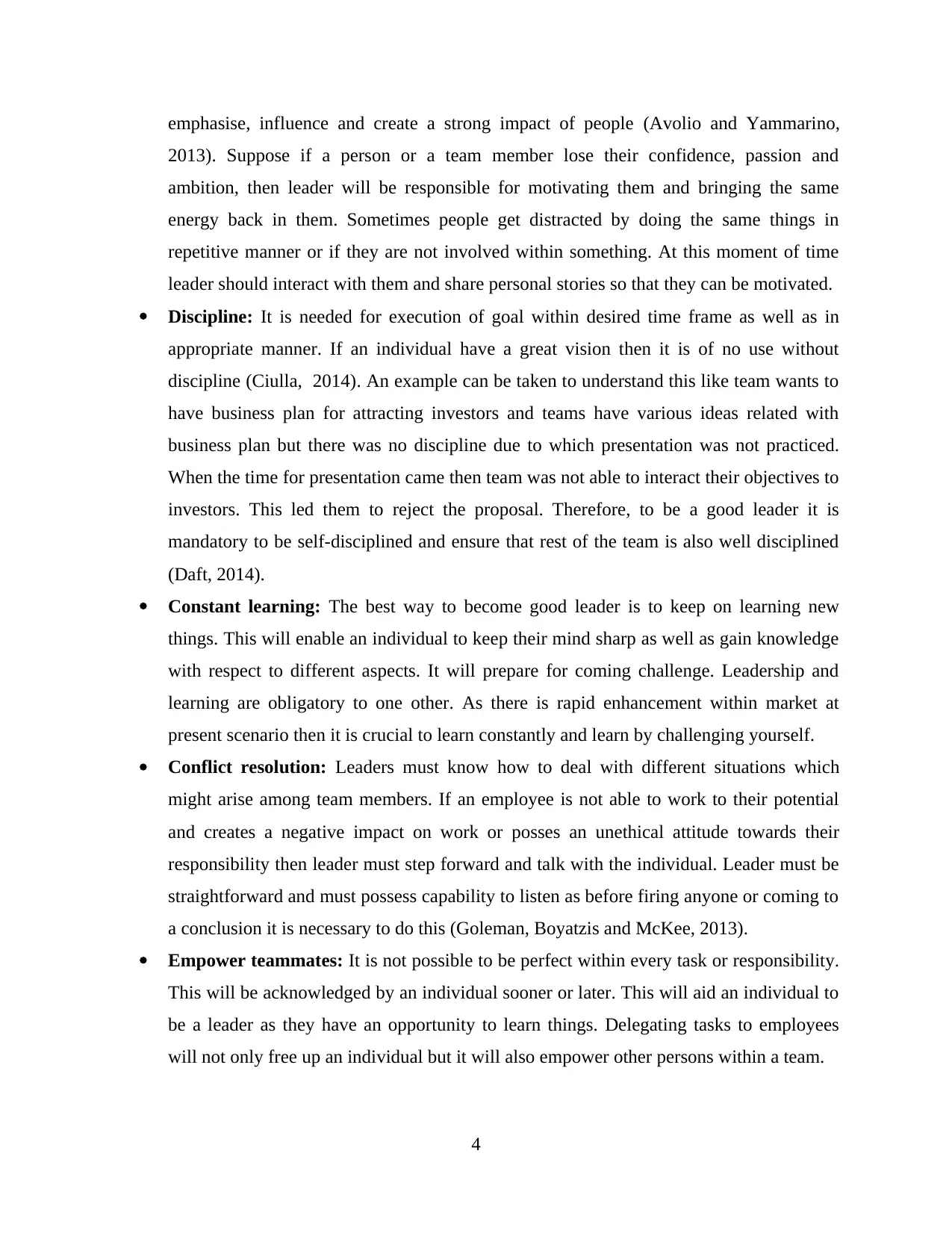
emphasise, influence and create a strong impact of people (Avolio and Yammarino,
2013). Suppose if a person or a team member lose their confidence, passion and
ambition, then leader will be responsible for motivating them and bringing the same
energy back in them. Sometimes people get distracted by doing the same things in
repetitive manner or if they are not involved within something. At this moment of time
leader should interact with them and share personal stories so that they can be motivated.
Discipline: It is needed for execution of goal within desired time frame as well as in
appropriate manner. If an individual have a great vision then it is of no use without
discipline (Ciulla, 2014). An example can be taken to understand this like team wants to
have business plan for attracting investors and teams have various ideas related with
business plan but there was no discipline due to which presentation was not practiced.
When the time for presentation came then team was not able to interact their objectives to
investors. This led them to reject the proposal. Therefore, to be a good leader it is
mandatory to be self-disciplined and ensure that rest of the team is also well disciplined
(Daft, 2014).
Constant learning: The best way to become good leader is to keep on learning new
things. This will enable an individual to keep their mind sharp as well as gain knowledge
with respect to different aspects. It will prepare for coming challenge. Leadership and
learning are obligatory to one other. As there is rapid enhancement within market at
present scenario then it is crucial to learn constantly and learn by challenging yourself.
Conflict resolution: Leaders must know how to deal with different situations which
might arise among team members. If an employee is not able to work to their potential
and creates a negative impact on work or posses an unethical attitude towards their
responsibility then leader must step forward and talk with the individual. Leader must be
straightforward and must possess capability to listen as before firing anyone or coming to
a conclusion it is necessary to do this (Goleman, Boyatzis and McKee, 2013).
Empower teammates: It is not possible to be perfect within every task or responsibility.
This will be acknowledged by an individual sooner or later. This will aid an individual to
be a leader as they have an opportunity to learn things. Delegating tasks to employees
will not only free up an individual but it will also empower other persons within a team.
4
2013). Suppose if a person or a team member lose their confidence, passion and
ambition, then leader will be responsible for motivating them and bringing the same
energy back in them. Sometimes people get distracted by doing the same things in
repetitive manner or if they are not involved within something. At this moment of time
leader should interact with them and share personal stories so that they can be motivated.
Discipline: It is needed for execution of goal within desired time frame as well as in
appropriate manner. If an individual have a great vision then it is of no use without
discipline (Ciulla, 2014). An example can be taken to understand this like team wants to
have business plan for attracting investors and teams have various ideas related with
business plan but there was no discipline due to which presentation was not practiced.
When the time for presentation came then team was not able to interact their objectives to
investors. This led them to reject the proposal. Therefore, to be a good leader it is
mandatory to be self-disciplined and ensure that rest of the team is also well disciplined
(Daft, 2014).
Constant learning: The best way to become good leader is to keep on learning new
things. This will enable an individual to keep their mind sharp as well as gain knowledge
with respect to different aspects. It will prepare for coming challenge. Leadership and
learning are obligatory to one other. As there is rapid enhancement within market at
present scenario then it is crucial to learn constantly and learn by challenging yourself.
Conflict resolution: Leaders must know how to deal with different situations which
might arise among team members. If an employee is not able to work to their potential
and creates a negative impact on work or posses an unethical attitude towards their
responsibility then leader must step forward and talk with the individual. Leader must be
straightforward and must possess capability to listen as before firing anyone or coming to
a conclusion it is necessary to do this (Goleman, Boyatzis and McKee, 2013).
Empower teammates: It is not possible to be perfect within every task or responsibility.
This will be acknowledged by an individual sooner or later. This will aid an individual to
be a leader as they have an opportunity to learn things. Delegating tasks to employees
will not only free up an individual but it will also empower other persons within a team.
4
⊘ This is a preview!⊘
Do you want full access?
Subscribe today to unlock all pages.

Trusted by 1+ million students worldwide
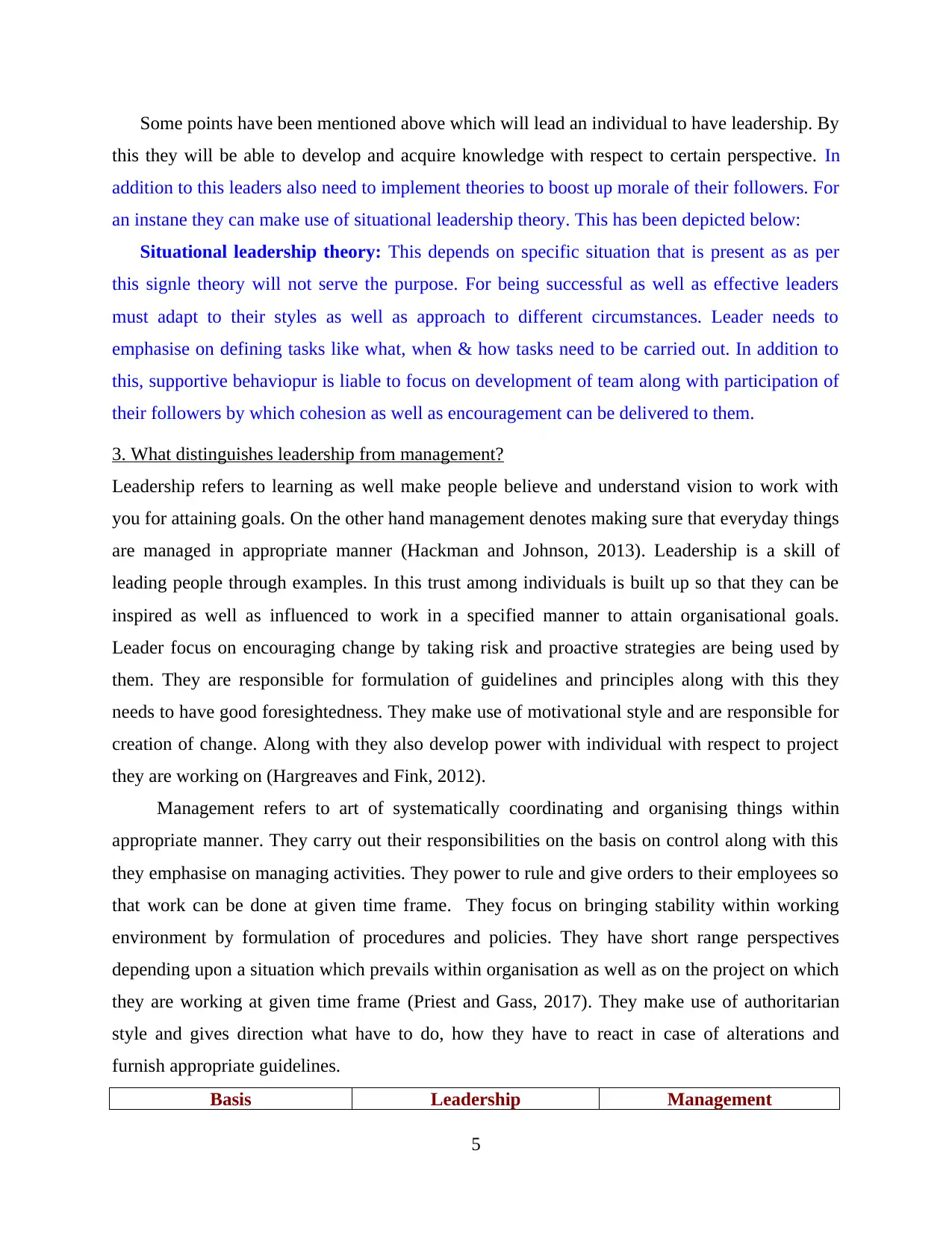
Some points have been mentioned above which will lead an individual to have leadership. By
this they will be able to develop and acquire knowledge with respect to certain perspective. In
addition to this leaders also need to implement theories to boost up morale of their followers. For
an instane they can make use of situational leadership theory. This has been depicted below:
Situational leadership theory: This depends on specific situation that is present as as per
this signle theory will not serve the purpose. For being successful as well as effective leaders
must adapt to their styles as well as approach to different circumstances. Leader needs to
emphasise on defining tasks like what, when & how tasks need to be carried out. In addition to
this, supportive behaviopur is liable to focus on development of team along with participation of
their followers by which cohesion as well as encouragement can be delivered to them.
3. What distinguishes leadership from management?
Leadership refers to learning as well make people believe and understand vision to work with
you for attaining goals. On the other hand management denotes making sure that everyday things
are managed in appropriate manner (Hackman and Johnson, 2013). Leadership is a skill of
leading people through examples. In this trust among individuals is built up so that they can be
inspired as well as influenced to work in a specified manner to attain organisational goals.
Leader focus on encouraging change by taking risk and proactive strategies are being used by
them. They are responsible for formulation of guidelines and principles along with this they
needs to have good foresightedness. They make use of motivational style and are responsible for
creation of change. Along with they also develop power with individual with respect to project
they are working on (Hargreaves and Fink, 2012).
Management refers to art of systematically coordinating and organising things within
appropriate manner. They carry out their responsibilities on the basis on control along with this
they emphasise on managing activities. They power to rule and give orders to their employees so
that work can be done at given time frame. They focus on bringing stability within working
environment by formulation of procedures and policies. They have short range perspectives
depending upon a situation which prevails within organisation as well as on the project on which
they are working at given time frame (Priest and Gass, 2017). They make use of authoritarian
style and gives direction what have to do, how they have to react in case of alterations and
furnish appropriate guidelines.
Basis Leadership Management
5
this they will be able to develop and acquire knowledge with respect to certain perspective. In
addition to this leaders also need to implement theories to boost up morale of their followers. For
an instane they can make use of situational leadership theory. This has been depicted below:
Situational leadership theory: This depends on specific situation that is present as as per
this signle theory will not serve the purpose. For being successful as well as effective leaders
must adapt to their styles as well as approach to different circumstances. Leader needs to
emphasise on defining tasks like what, when & how tasks need to be carried out. In addition to
this, supportive behaviopur is liable to focus on development of team along with participation of
their followers by which cohesion as well as encouragement can be delivered to them.
3. What distinguishes leadership from management?
Leadership refers to learning as well make people believe and understand vision to work with
you for attaining goals. On the other hand management denotes making sure that everyday things
are managed in appropriate manner (Hackman and Johnson, 2013). Leadership is a skill of
leading people through examples. In this trust among individuals is built up so that they can be
inspired as well as influenced to work in a specified manner to attain organisational goals.
Leader focus on encouraging change by taking risk and proactive strategies are being used by
them. They are responsible for formulation of guidelines and principles along with this they
needs to have good foresightedness. They make use of motivational style and are responsible for
creation of change. Along with they also develop power with individual with respect to project
they are working on (Hargreaves and Fink, 2012).
Management refers to art of systematically coordinating and organising things within
appropriate manner. They carry out their responsibilities on the basis on control along with this
they emphasise on managing activities. They power to rule and give orders to their employees so
that work can be done at given time frame. They focus on bringing stability within working
environment by formulation of procedures and policies. They have short range perspectives
depending upon a situation which prevails within organisation as well as on the project on which
they are working at given time frame (Priest and Gass, 2017). They make use of authoritarian
style and gives direction what have to do, how they have to react in case of alterations and
furnish appropriate guidelines.
Basis Leadership Management
5
Paraphrase This Document
Need a fresh take? Get an instant paraphrase of this document with our AI Paraphraser
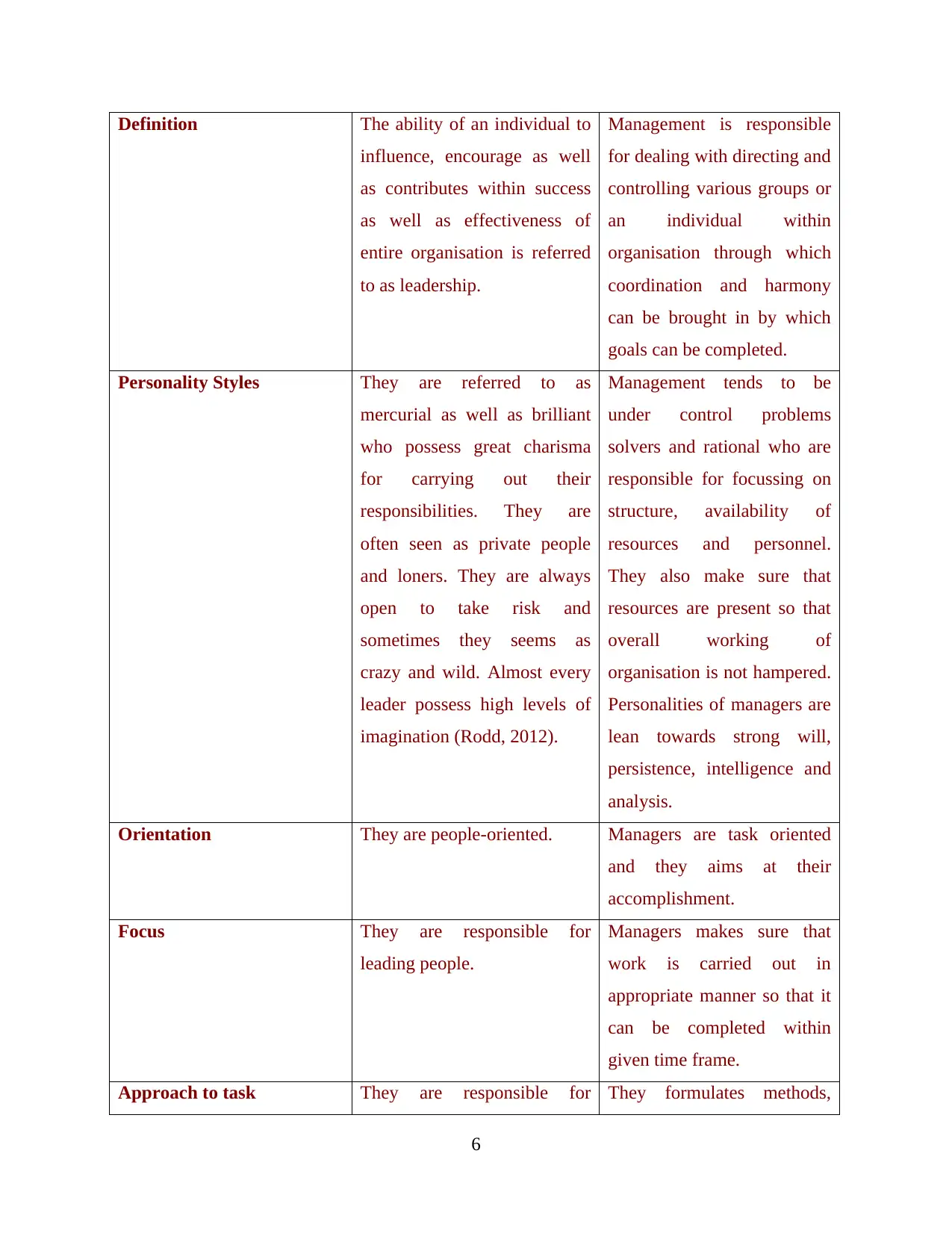
Definition The ability of an individual to
influence, encourage as well
as contributes within success
as well as effectiveness of
entire organisation is referred
to as leadership.
Management is responsible
for dealing with directing and
controlling various groups or
an individual within
organisation through which
coordination and harmony
can be brought in by which
goals can be completed.
Personality Styles They are referred to as
mercurial as well as brilliant
who possess great charisma
for carrying out their
responsibilities. They are
often seen as private people
and loners. They are always
open to take risk and
sometimes they seems as
crazy and wild. Almost every
leader possess high levels of
imagination (Rodd, 2012).
Management tends to be
under control problems
solvers and rational who are
responsible for focussing on
structure, availability of
resources and personnel.
They also make sure that
resources are present so that
overall working of
organisation is not hampered.
Personalities of managers are
lean towards strong will,
persistence, intelligence and
analysis.
Orientation They are people-oriented. Managers are task oriented
and they aims at their
accomplishment.
Focus They are responsible for
leading people.
Managers makes sure that
work is carried out in
appropriate manner so that it
can be completed within
given time frame.
Approach to task They are responsible for They formulates methods,
6
influence, encourage as well
as contributes within success
as well as effectiveness of
entire organisation is referred
to as leadership.
Management is responsible
for dealing with directing and
controlling various groups or
an individual within
organisation through which
coordination and harmony
can be brought in by which
goals can be completed.
Personality Styles They are referred to as
mercurial as well as brilliant
who possess great charisma
for carrying out their
responsibilities. They are
often seen as private people
and loners. They are always
open to take risk and
sometimes they seems as
crazy and wild. Almost every
leader possess high levels of
imagination (Rodd, 2012).
Management tends to be
under control problems
solvers and rational who are
responsible for focussing on
structure, availability of
resources and personnel.
They also make sure that
resources are present so that
overall working of
organisation is not hampered.
Personalities of managers are
lean towards strong will,
persistence, intelligence and
analysis.
Orientation They are people-oriented. Managers are task oriented
and they aims at their
accomplishment.
Focus They are responsible for
leading people.
Managers makes sure that
work is carried out in
appropriate manner so that it
can be completed within
given time frame.
Approach to task They are responsible for They formulates methods,
6
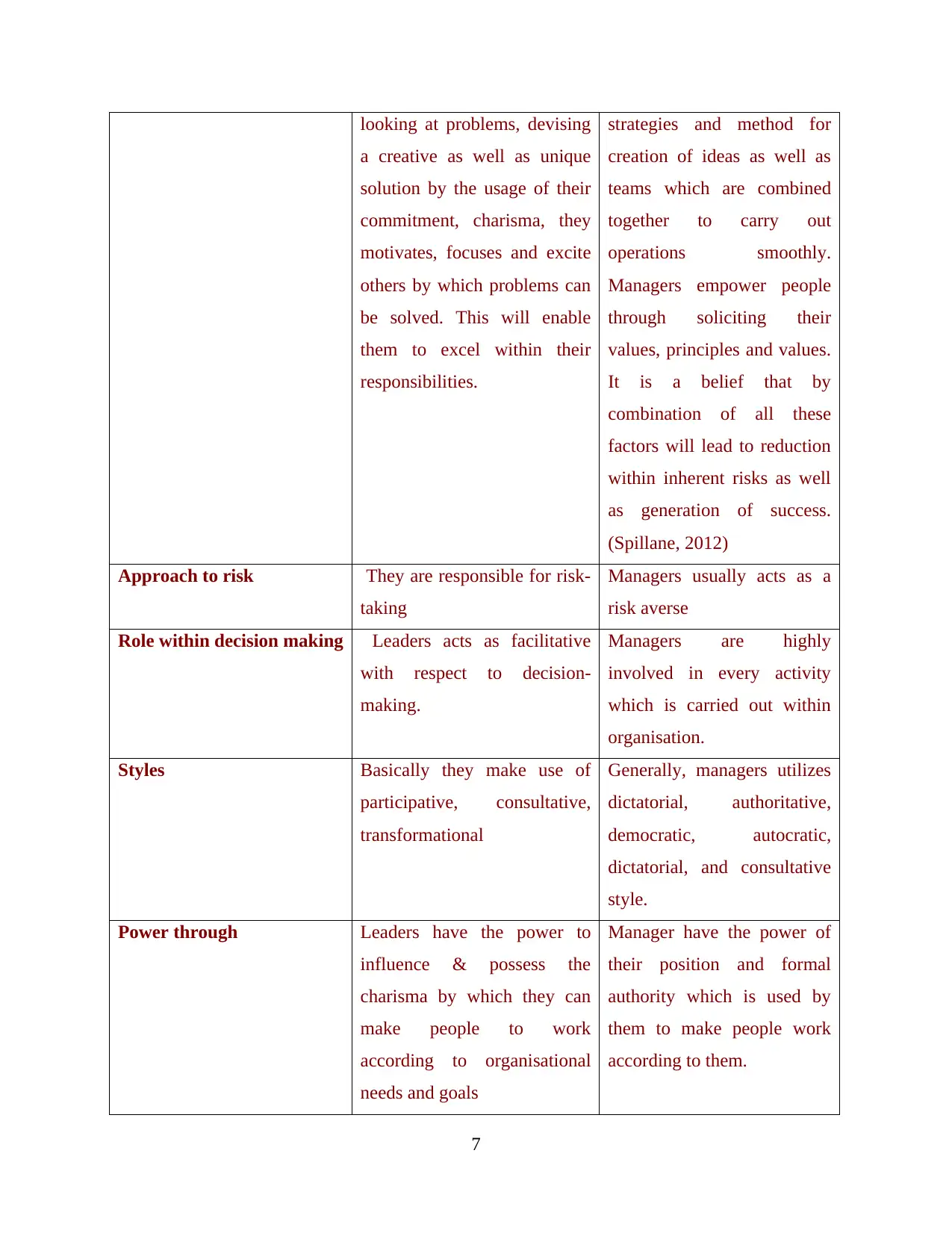
looking at problems, devising
a creative as well as unique
solution by the usage of their
commitment, charisma, they
motivates, focuses and excite
others by which problems can
be solved. This will enable
them to excel within their
responsibilities.
strategies and method for
creation of ideas as well as
teams which are combined
together to carry out
operations smoothly.
Managers empower people
through soliciting their
values, principles and values.
It is a belief that by
combination of all these
factors will lead to reduction
within inherent risks as well
as generation of success.
(Spillane, 2012)
Approach to risk They are responsible for risk-
taking
Managers usually acts as a
risk averse
Role within decision making Leaders acts as facilitative
with respect to decision-
making.
Managers are highly
involved in every activity
which is carried out within
organisation.
Styles Basically they make use of
participative, consultative,
transformational
Generally, managers utilizes
dictatorial, authoritative,
democratic, autocratic,
dictatorial, and consultative
style.
Power through Leaders have the power to
influence & possess the
charisma by which they can
make people to work
according to organisational
needs and goals
Manager have the power of
their position and formal
authority which is used by
them to make people work
according to them.
7
a creative as well as unique
solution by the usage of their
commitment, charisma, they
motivates, focuses and excite
others by which problems can
be solved. This will enable
them to excel within their
responsibilities.
strategies and method for
creation of ideas as well as
teams which are combined
together to carry out
operations smoothly.
Managers empower people
through soliciting their
values, principles and values.
It is a belief that by
combination of all these
factors will lead to reduction
within inherent risks as well
as generation of success.
(Spillane, 2012)
Approach to risk They are responsible for risk-
taking
Managers usually acts as a
risk averse
Role within decision making Leaders acts as facilitative
with respect to decision-
making.
Managers are highly
involved in every activity
which is carried out within
organisation.
Styles Basically they make use of
participative, consultative,
transformational
Generally, managers utilizes
dictatorial, authoritative,
democratic, autocratic,
dictatorial, and consultative
style.
Power through Leaders have the power to
influence & possess the
charisma by which they can
make people to work
according to organisational
needs and goals
Manager have the power of
their position and formal
authority which is used by
them to make people work
according to them.
7
⊘ This is a preview!⊘
Do you want full access?
Subscribe today to unlock all pages.

Trusted by 1+ million students worldwide
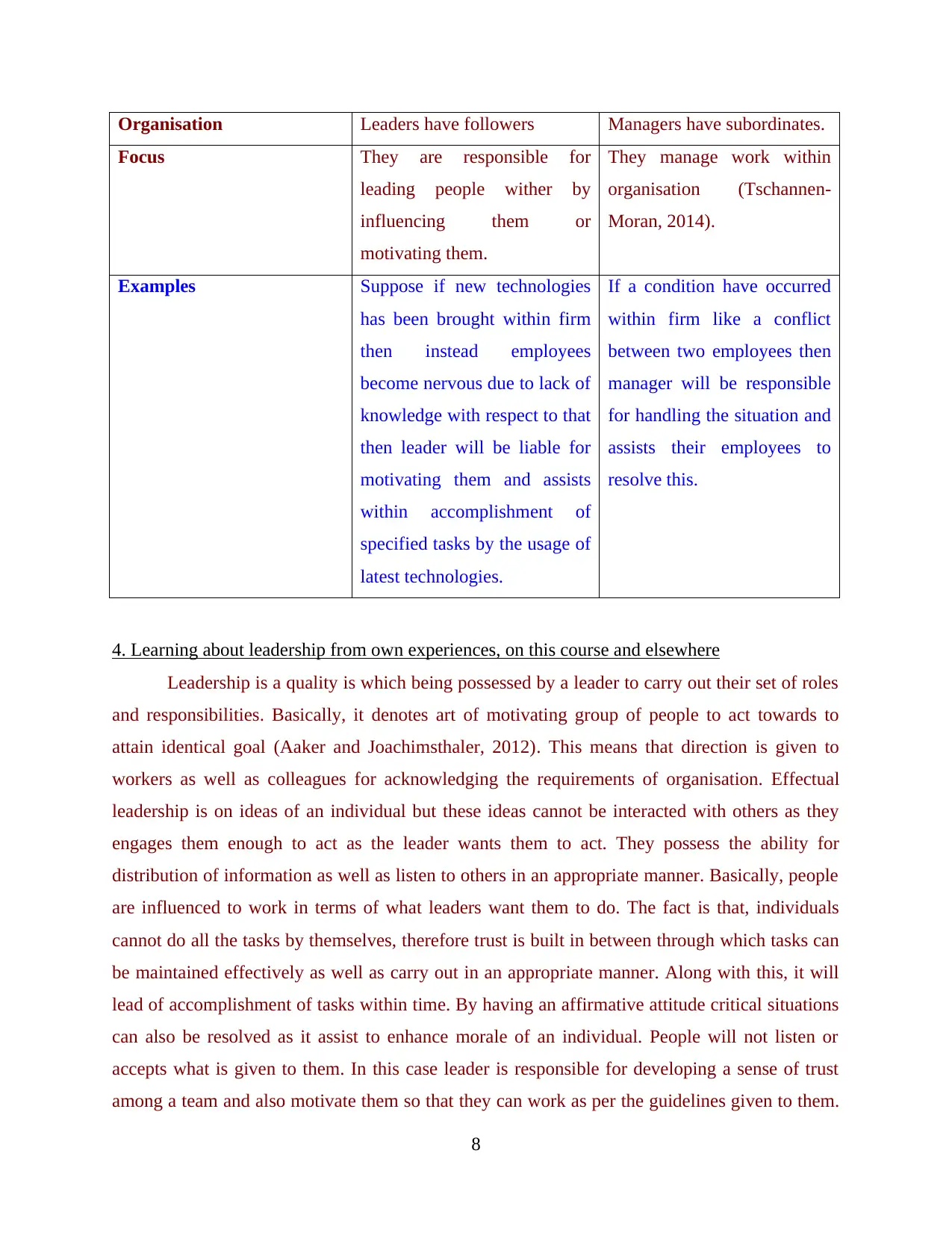
Organisation Leaders have followers Managers have subordinates.
Focus They are responsible for
leading people wither by
influencing them or
motivating them.
They manage work within
organisation (Tschannen-
Moran, 2014).
Examples Suppose if new technologies
has been brought within firm
then instead employees
become nervous due to lack of
knowledge with respect to that
then leader will be liable for
motivating them and assists
within accomplishment of
specified tasks by the usage of
latest technologies.
If a condition have occurred
within firm like a conflict
between two employees then
manager will be responsible
for handling the situation and
assists their employees to
resolve this.
4. Learning about leadership from own experiences, on this course and elsewhere
Leadership is a quality is which being possessed by a leader to carry out their set of roles
and responsibilities. Basically, it denotes art of motivating group of people to act towards to
attain identical goal (Aaker and Joachimsthaler, 2012). This means that direction is given to
workers as well as colleagues for acknowledging the requirements of organisation. Effectual
leadership is on ideas of an individual but these ideas cannot be interacted with others as they
engages them enough to act as the leader wants them to act. They possess the ability for
distribution of information as well as listen to others in an appropriate manner. Basically, people
are influenced to work in terms of what leaders want them to do. The fact is that, individuals
cannot do all the tasks by themselves, therefore trust is built in between through which tasks can
be maintained effectively as well as carry out in an appropriate manner. Along with this, it will
lead of accomplishment of tasks within time. By having an affirmative attitude critical situations
can also be resolved as it assist to enhance morale of an individual. People will not listen or
accepts what is given to them. In this case leader is responsible for developing a sense of trust
among a team and also motivate them so that they can work as per the guidelines given to them.
8
Focus They are responsible for
leading people wither by
influencing them or
motivating them.
They manage work within
organisation (Tschannen-
Moran, 2014).
Examples Suppose if new technologies
has been brought within firm
then instead employees
become nervous due to lack of
knowledge with respect to that
then leader will be liable for
motivating them and assists
within accomplishment of
specified tasks by the usage of
latest technologies.
If a condition have occurred
within firm like a conflict
between two employees then
manager will be responsible
for handling the situation and
assists their employees to
resolve this.
4. Learning about leadership from own experiences, on this course and elsewhere
Leadership is a quality is which being possessed by a leader to carry out their set of roles
and responsibilities. Basically, it denotes art of motivating group of people to act towards to
attain identical goal (Aaker and Joachimsthaler, 2012). This means that direction is given to
workers as well as colleagues for acknowledging the requirements of organisation. Effectual
leadership is on ideas of an individual but these ideas cannot be interacted with others as they
engages them enough to act as the leader wants them to act. They possess the ability for
distribution of information as well as listen to others in an appropriate manner. Basically, people
are influenced to work in terms of what leaders want them to do. The fact is that, individuals
cannot do all the tasks by themselves, therefore trust is built in between through which tasks can
be maintained effectively as well as carry out in an appropriate manner. Along with this, it will
lead of accomplishment of tasks within time. By having an affirmative attitude critical situations
can also be resolved as it assist to enhance morale of an individual. People will not listen or
accepts what is given to them. In this case leader is responsible for developing a sense of trust
among a team and also motivate them so that they can work as per the guidelines given to them.
8
Paraphrase This Document
Need a fresh take? Get an instant paraphrase of this document with our AI Paraphraser
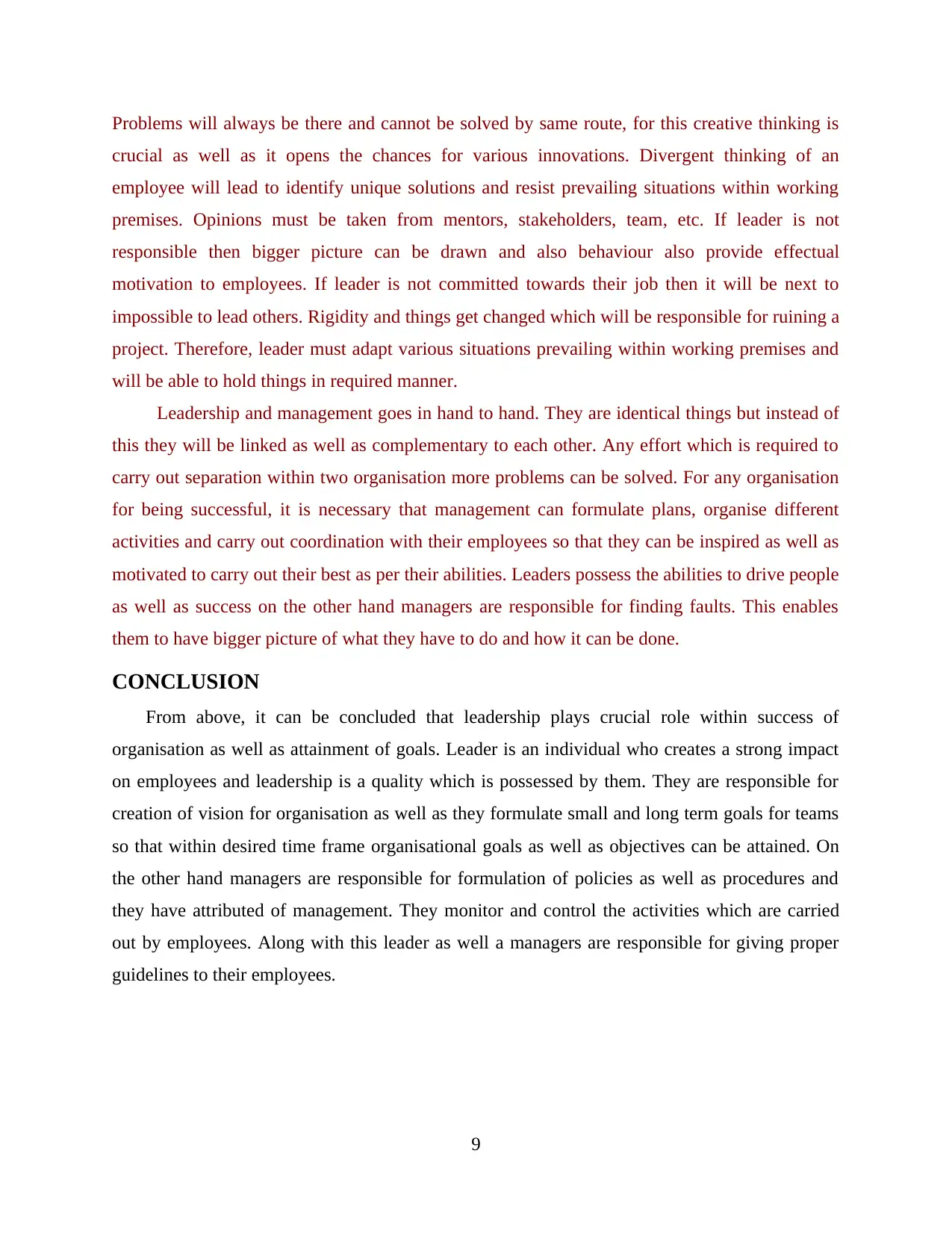
Problems will always be there and cannot be solved by same route, for this creative thinking is
crucial as well as it opens the chances for various innovations. Divergent thinking of an
employee will lead to identify unique solutions and resist prevailing situations within working
premises. Opinions must be taken from mentors, stakeholders, team, etc. If leader is not
responsible then bigger picture can be drawn and also behaviour also provide effectual
motivation to employees. If leader is not committed towards their job then it will be next to
impossible to lead others. Rigidity and things get changed which will be responsible for ruining a
project. Therefore, leader must adapt various situations prevailing within working premises and
will be able to hold things in required manner.
Leadership and management goes in hand to hand. They are identical things but instead of
this they will be linked as well as complementary to each other. Any effort which is required to
carry out separation within two organisation more problems can be solved. For any organisation
for being successful, it is necessary that management can formulate plans, organise different
activities and carry out coordination with their employees so that they can be inspired as well as
motivated to carry out their best as per their abilities. Leaders possess the abilities to drive people
as well as success on the other hand managers are responsible for finding faults. This enables
them to have bigger picture of what they have to do and how it can be done.
CONCLUSION
From above, it can be concluded that leadership plays crucial role within success of
organisation as well as attainment of goals. Leader is an individual who creates a strong impact
on employees and leadership is a quality which is possessed by them. They are responsible for
creation of vision for organisation as well as they formulate small and long term goals for teams
so that within desired time frame organisational goals as well as objectives can be attained. On
the other hand managers are responsible for formulation of policies as well as procedures and
they have attributed of management. They monitor and control the activities which are carried
out by employees. Along with this leader as well a managers are responsible for giving proper
guidelines to their employees.
9
crucial as well as it opens the chances for various innovations. Divergent thinking of an
employee will lead to identify unique solutions and resist prevailing situations within working
premises. Opinions must be taken from mentors, stakeholders, team, etc. If leader is not
responsible then bigger picture can be drawn and also behaviour also provide effectual
motivation to employees. If leader is not committed towards their job then it will be next to
impossible to lead others. Rigidity and things get changed which will be responsible for ruining a
project. Therefore, leader must adapt various situations prevailing within working premises and
will be able to hold things in required manner.
Leadership and management goes in hand to hand. They are identical things but instead of
this they will be linked as well as complementary to each other. Any effort which is required to
carry out separation within two organisation more problems can be solved. For any organisation
for being successful, it is necessary that management can formulate plans, organise different
activities and carry out coordination with their employees so that they can be inspired as well as
motivated to carry out their best as per their abilities. Leaders possess the abilities to drive people
as well as success on the other hand managers are responsible for finding faults. This enables
them to have bigger picture of what they have to do and how it can be done.
CONCLUSION
From above, it can be concluded that leadership plays crucial role within success of
organisation as well as attainment of goals. Leader is an individual who creates a strong impact
on employees and leadership is a quality which is possessed by them. They are responsible for
creation of vision for organisation as well as they formulate small and long term goals for teams
so that within desired time frame organisational goals as well as objectives can be attained. On
the other hand managers are responsible for formulation of policies as well as procedures and
they have attributed of management. They monitor and control the activities which are carried
out by employees. Along with this leader as well a managers are responsible for giving proper
guidelines to their employees.
9

REFERENCE
Books & Journals
10
Books & Journals
10
⊘ This is a preview!⊘
Do you want full access?
Subscribe today to unlock all pages.

Trusted by 1+ million students worldwide
1 out of 13
Related Documents
Your All-in-One AI-Powered Toolkit for Academic Success.
+13062052269
info@desklib.com
Available 24*7 on WhatsApp / Email
![[object Object]](/_next/static/media/star-bottom.7253800d.svg)
Unlock your academic potential
Copyright © 2020–2025 A2Z Services. All Rights Reserved. Developed and managed by ZUCOL.


